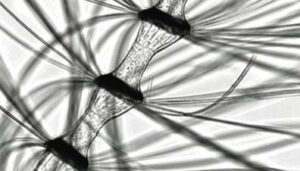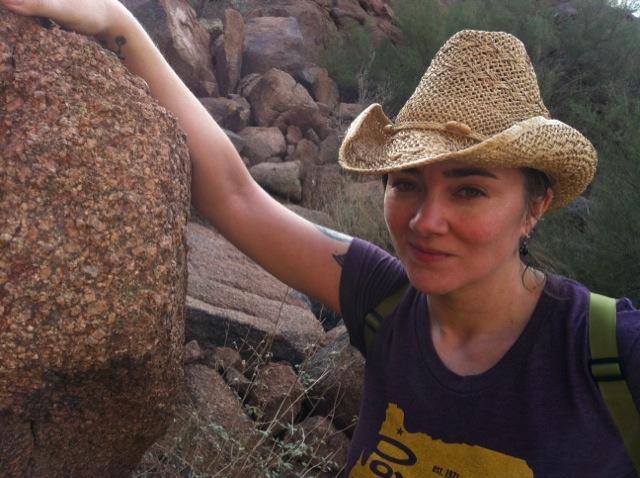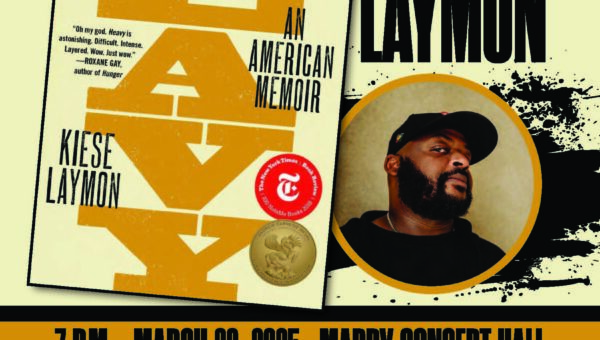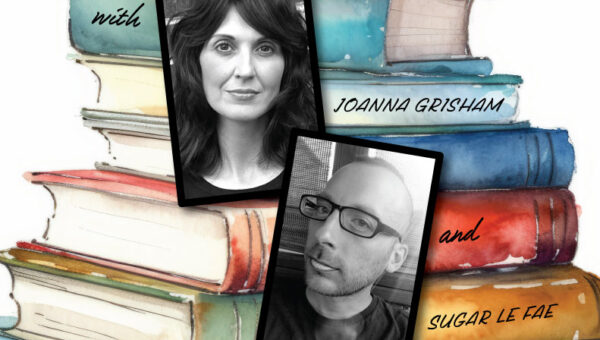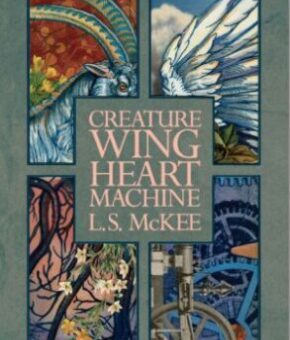Amy Wright: The Skinned Bird is divided into four sections, each of which invokes the stages birds undergo as they learn songs. How did this metaphor become central to your debut essay collection?
Chelsea Biondolillo: That first essay, which outlines the four sections and describes how they work in bird and human language acquisition, was actually one of the last essays I wrote before submitting the book to presses. Because it includes many of the motifs from elsewhere in the collection: my parents, birds, divorce, generalized heartbreak, after it was done, I realized that it was a kind of Rosetta stone—that I could use it to translate the ideas I’d circled around elsewhere in the collection into a coherent arc. In the initial drafts of the manuscript, the essays were organized chronologically, but I was frustrated with the case they made that life starts at A then moves to B, a series of Mondays followed by Tuesdays. It felt more circular, more like repetitive Groundhog Days followed by a month of Friday nights spent falling in love & Monday morning breakups. Thinking about the essays as describing a process of building a flawed self, and then using the way birds (and people) acquire the vocabularies they need to sing their songs of themselves as a frame for that process gave the collection a narrative shape I could get behind from a craft perspective, but it also helped me find some compassion for my narrator (spoiler: it’s me).
Wright: The first essay in the collection describes your parents’ marriage ending when you were not yet three. Since later essays detail the end of your own marriage, the ghost of lost love haunts this collection. Did you write this book to give form to what you never got to experience, which was “the shape and sound of their love”?
Biondolillo: I’ve been thinking a lot about this question because I hadn’t thought of it that way, but evidence is readily available in the book to make this case. For so long I’d held onto a lot of shame about my inability to make good-job-good-marriage-good-house happen. This book and these essays aren’t about placing blame for my perpetual broken-heartedness on my parents’ unhappy union, but I do think these essays are a way of showing how faulty messages reverberate through our experiences, often in ways that cannot be pre-visualized.
Ultimately, we are each of us a bundle of messaging, and then we pack ourselves together with other bundles, all telegraphing our senses of selves out into the void, hoping to hear back a note or two of recognition. This book is my attempt to explore how my voice was forged, in heartbreak and un-ease, and why it therefore tends to sing in a creepy, minor key.
Wright: Your wedding band had been a tattoo on your finger, which you look at differently after your marriage ends. You liken a tattoo to a process that contrasts with the structure of an essay, which strives toward conclusion. Will you elaborate on how you relate to these two forms of ink?
Biondolillo: I think that essays strive toward resolutions, but regardless of whether they find one, they each arrive at an ending by necessity. I’d always loved tattoos for their permanence, so the ring had been a bit of a metaphysical burr for me, because its permanence belied the til-death-do-us-part business that it commemorated. I was often weary of the haha! what irony! aspect of the thing, even as I liked the aesthetics of it. This ambivalence is why it took me over a year to find the right ending for that essay. In my shitty first drafts, I didn’t know whether I was defending the tattoo or the divorce or just telling a nineties origin story, or what, and it wasn’t until a trusted reader said they’d like to know a bit more about tattoos themselves that I found the key for this one in the mechanics of tattoo ink and the body’s response to it. I had to write/root around for a bit until I saw the essay’s direction, and then I could head toward its conclusion with purpose.
In this way, an essay can be an iterative and active process—like a pencil or charcoal drawing that you mark, then erase, then mark again until you find the drawing you saw in your mind on the page. A tattoo pretty much has to be right the first time (excepting lasers and cover-ups), lest you end up with regrets.
Wright: What do you imagine is the relationship between writing and the body?
Biondolillo: The act of mark-making, which I consider writing to be a form of, feels to me like an extension of bodily autonomy and agency. I think therefore I am, but when I make this mark, it says I am here. I can “sing my body electric” and/or story my body oceanic, essay my body seismic, “selfie” my body astronomic—these acts connect the body and mind to the physical world by means of an artefact.
As an undergraduate student, I was once tasked by an art history teacher to create (in a small group) a manifesto. Our four quickly whittled down to two when we two held firm to certain lofty ideals about the natural world and poetry, and my colleague and I came up with what we called “The Spiritist Manifesto.” We filled it with exultant lines from our favorite poets and nature writing and joy and hope, and when it came time to present it, we did so with gusto. The professor, all leather elbow patches and unlit pipe in his mouth, said only, “And here we have the Romantics” before moving on to the next group and a lively discussion about the merits of nihilism in an age of unchecked capitalism. It was a crushing blow to my earnest self and this question feels a bit like that moment, because I am showing a tender beating soft-heart, here—but I really do think we paint or dance or write to give shape and form to how it feels to be a (flawed) human being in a(n imperfect) body on this planet.
Anyone who writes, writes across a great chasm, from in here [taps temple] to way over there, where you, trees, salamanders, bicycles, coffee cups, condors, dead grandmothers, mosquitoes, rose bushes, hydroelectric dams, toothbrushes, ex-presidents, subways, sea coral, telemarketers, romantic restaurants, car exhaust, new mothers, moss, elephants, machine guns, salmonella, bower birds, bottle caps, ramen, every other person and the whole wild mess of everything exists. And I write across it in the hope of building a bridge, to get what’s in here out there, and vice versa.
Wright: The Skinned Bird includes a map, labeled “Migration,” that depicts eleven moves you have made in the U.S. Rather than a single pathway to and from home, points zigzag and sometimes stop cold. Only after some scrutiny does Phoenix, Arizona emerge as a homing ground. What is it about this city that sends you away and pulls you back?
Biondolillo: My mother left Portland for a better job the year before I did (I left for love and adventure and definitely not for fortune). She and my stepfather landed in Phoenix and they stayed there until recently. Each time in my life when I’ve lost everything / run out of options (three times now, for the fans keeping score at home) my mother tells me I am more than welcome to stay with them until I get back on my feet. It is a privilege that has allowed me to take some career risks, even if it comes with its own kind of cost. I always joke that Phoenix is a place I have regularly ended up in the same way that hair collects in a drain.
So, it has served as a kind of home, but not Home, because their place in Phoenix never had “my old room” in it or boxes of my baby stuff, and the neighborhood—full of date palms and agaves—was nothing like the temperate and damp one I roamed as a nerdy, lonely kid. The home I’d had no longer existed. I think this was part of the reason that my many cross-country moves always felt temporary. Trips back to Portland were frustrating because so much had changed there and my friends and family were all leaving in one way or another, and other towns had their qualities, but none felt quite right. This last year in my grandmother’s old house (now my house) about 30 miles outside of Portland, I’ve been thinking a lot about how much of “Home” is something you can shape and craft versus how much of it is an irrational animal feeling. The Skinned Bird hints at those ideas, especially in the final section.
Wright: When in your life have you felt the freest?
Biondolillo: There have been times in my life when I felt a great deal of confidence in my ability to navigate a space or place—like getting through Penn Station to find my train to New Jersey, decoding the Paris Metro to find the famous neon windmill, driving across country to the sounds of my shuffling iPod and a GPS, finding the trail again after losing it in the snow while hiking in Wyoming. My anxiety makes these times rare—usually I get lost and become a bawling mess—but when I know how to figure out the path from A to B, when I have what I need to chart a course, then I feel very free to enjoy the journey.
Wright: In your essay “Meteorology,” you describe lightning as “the white legs of the cumulonimbus…burning black tracks in the sand.” Although the concern of this essay is not climate change, it still reminds me of dramatic weather events like when a shockwave sets off a car alarm. How do you relate to climate change?
Biondolillo: The situation with the climate is dire and I believe that catastrophic impacts are unavoidable at this point. I maintain a kernel of optimism, though, because we are nothing if not inventive animals. I think that technology and innovation can help us slow the rising CO2 levels and manage the inevitable changes, and there is already a global movement in this direction. The U.S. is behind here, and likely won’t catch up for a while without economic incentives, but most of the rest of the world seems to get it. My more immediate concern is whether we can manage a global humanitarian crisis as well as an ecological one. Because climate change will disproportionally affect already marginalized and disadvantaged people the world over—people who can’t move to higher ground, who can’t afford more expensive produce, who don’t have a say in the political decisions deciding their fate. Will we develop technologies and systems that help the many or the few? Adopting isolating, exclusionary policies (as the U.S. and several European countries are already doing) will hurt everyone in the long run. Since my own creativity and innovation is fueled by compassion, a guiding principle of compassion is what I look for in any conversation aimed at solving or ameliorating the problem.
Wright: You write: “If, for example, I’d sometimes like to imagine that my insecurities are the function of a sublime natural order, a restlessness that speaks to and through stars or tides or tectonic plates, it isn’t because I need to feel more important than I am, but less singular.” What does it mean to you to feel less singular?
Biondolillo: We all walk around the tips of icebergs with so much of our histories, fears, hopes, and dreams below the surface of the face we present to the world. Since we can’t see what lies beneath, except through filtered reports, it’s easy to fall into the trap of thinking that you are alone in your worries or triumphs. People often tell me they appreciate the “honesty” in my writing and social media presence. Often, they mean my willingness to be sad or anxious or unsatisfied in public. I’ve written about failure and breakups and unassuageable melancholy because I experience them often. Those are things we have all experienced at one time or another! But especially in this social media age, where the self as marketable content has created a tendency to present only desirable, pleasant aspects of one’s life, there is such peer pressure to pretend that you don’t whine or bicker or ugly-cry. I don’t believe it is admirable to nurse 30-year-old wounds from slumber-party arguments which were (and remain) inconsequential given the over-arching mechanisms of the universe, but I also don’t believe I’m the only one who does it. And I consider it an act of community building to value embarrassing and hard feelings—the petty and the anxious feelings of loss and not-fitting-in, the over-earnest feelings of young love and the cynicism of heartbreak—as much as socially acceptable feelings.
Wright: You write about opening birds in science class, and peeling back “the skin of a life from the bones of its house.” Is violation inherent in the acquisition of knowledge?
Biondolillo: Wow. That’s such a great question. I wanted to immediately rush in with “No, no!” But the more I think about it, in the physical and social sciences, we cut, grind, split, dissolve, interrogate, examine, and analyze—all acts of violation, of the cell, the individual, of the whole, in one way or another. Perhaps that’s the role of artists, then: to identify, honor, and when possible, suture those openings.
Wright: In your concluding essay, you write: “Scientific inquiry, like the mess of living it seeks to inform, can resist our inclinations to order its results.” Do you see artistic inquiry as less resistant to this inclination, or better able to order the results?
Biondolillo: I think that artists get a lot more leeway when it comes to defining their organizational principles than scientists do, and in presenting the results of their inquiry. (Or at least I think that as a practitioner of arts and an observer of science and scientists. I bet there’s a researcher out there observing art and artists saying the same thing about us.) In an essay, I can make ridiculous leaps of narrative and logic, from the red meat of a songbird to my grandmother’s oily trout, for example, and count on at least a few readers to follow me. But scientists who try to do the same are often not published/appreciated for a couple hundred years after their death.
Wright: You dedicate The Skinned Bird to your grandparents, saying in the book that at their house you felt best able to be yourself. How does permission to be yourself, or reluctance to do so, inform your writing?
Biondolillo: Claiming one’s own voice is a powerful act of resistance and resistance is exhausting. This is why some writing gets branded as “brave,” I think. The act of sitting down at your desk or wherever, and writing down words isn’t particularly brave in and of itself. But resisting all the direct and indirect social and cultural pressures that tell us—as artists, as writers, as women, as healthy or as sane, as victim or survivor—to shut the fuck up and get along, takes no small amount of strength and forbearance. When I read my grandmother’s old journals, there is so much yearning in them. She wanted to see the world and she wanted to document what she saw, and her geographic and economic isolation, not to mention what were likely struggles with her mental health, meant that very few people ever got to experience her photographs or her naturalist notes. There are hints in her life of no small amount of suffering, but hardly a contrary word appears in her writing—she wrote to fit in. My writing is in direct resistance to that idea.
This book isn’t only about my grandmother, but several of the essays deal directly with the ways the women in my early life taught me how to be in the world. Many of us grew up with faulty or unhelpful messages and I try to probe mine for the wisdom or truth they tried to convey, or to uncover the fallacies upon which they were built. And in doing that, I frame my own sadness, loss, heartbreak, and my love and discovery as part of a larger process—rather than a static result. We may none of us be perfect, but it is also true that none of us are stuck in our imperfect selves—every minute, every hour, every day is an opportunity to bend toward light.
* * *
Read “How to Skin a Bird,” an essay from Biondolillo’s collection, here: Sheandoah.
